Résultats de recherche de titre
Articles 1495261 à 1495280 sur 1497512
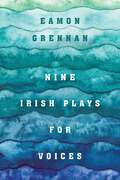
Nine Irish Plays for Voices
Par Eamon Grennan. 2023
A vibrant collection of short plays bringing Irish history and culture alive through an extraordinary collage of documents, songs, poems,…
and texts.In Nine Irish Plays for Voices, award-winning poet Eamon Grennan delves deep into key Irish subjects—big, small, literary, historical, political, biographical—and illuminates them for today’s audiences and readers. These short plays draw from original material centering on important moments in Irish history and the formation of the Irish Republic, such as the Great Famine and the Easter Rising; the lives of Irish literary figures like Yeats, Joyce, and Lady Gregory; and the crucial and life-changing condition of emigration.The rhythmic, musical, and vivid language of Grennan’s plays incorporates traditional song lyrics, lines of Irish poetry, and letters and speeches of the time. The result is a dramatic collage that tells a story through the voices of characters contemporary to the period of the play’s subject. By presenting subjects through the dramatic rendering of the human voice, the plays facilitate a close, intimate relationship between players and the audience, creating an incredibly powerful connection to the past. Historical moments and literary figures that might seem remote to the present-day reader or audience become immediate and emotionally compelling.One of the plays, Ferry, is drawn entirely from the author’s imagination. It puts unnamed characters who come from the world of twentieth-century Ireland on a boat to the underworld with the philosopher Ludwig Wittgenstein. On their journey the five strangers, played by two voices, tell stories about their lives, raising the question of how language both captures and transforms lived experience. Addressing the Great Famine, Hunger uses documentary evidence to give audiences a dramatic feel for what has been a silent and traumatic element in Irish history. Noramollyannalivialucia: The Muse and Mr. Joyce is a one-woman piece that depicts James Joyce’s wife as an older woman sharing her memories and snippets from the works of her husband. Also included in this rich volume is the author’s adaptation of Synge’s Aran Islands, as well as Emigration Road, History! Reading the Easter Rising, The Muse and Mr. Yeats, The Loves of Lady Gregory, and Peig: An Ordinary Life.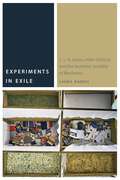
Comparing the radical aesthetic and social experiments undertaken by two exile intellectuals, Experiments in Exile charts a desire in their…
work to formulate alternative theories of citizenship, wherein common reception of popular cultural forms is linked to a potentially expanded, non-exclusive polity. By carefully analyzing the materiality of the multiply-lined, multiply voiced writing of the “undocuments” that record these social experiments and relay their prophetic descriptions of and instructions for the new social worlds they wished to forge and inhabit, however, it argues that their projects ultimately challenge rather than seek to rehabilitate normative conceptions of citizens and polities as well as authors and artworks. James and Oiticica’s experiments recall the insurgent sociality of “the motley crew” historians Peter Linebaugh and Marcus Rediker describe in The Many-Headed Hydra, their study of the trans-Atlantic, cross-gendered, multi-racial working class of the seventeenth and eighteenth centuries. Reading James’s and Oiticica’s projects against the grain of Linebaugh and Rediker’s inability to find evidence of that sociality’s persistence or futurity, it shows how James and Oiticica gravitate toward and seek to relay the ongoing renewal of dissident, dissonant social forms, which are for them always also aesthetic forms, in the barrack-yards of Port-of-Spain and the favelas of Rio de Janeiro, the assembly lines of Detroit and the streets of the New York. The formal openness and performative multiplicity that manifests itself at the place where writing and organizing converge invokes that sociality and provokes its ongoing re-invention. Their writing extends a radical, collective Afro-diasporic intellectuality, an aesthetic sociality of blackness, where blackness is understood not as the eclipse, but the ongoing transformative conservation of the motley crew’s multi-raciality. Blackness is further instantiated in the interracial and queer sexual relations, and in a new sexual metaphorics of production and reproduction, whose disruption and reconfiguration of gender structures the collaborations from which James’s and Oiticica’s undocuments emerge, orienting them towards new forms of social, aesthetic and intellectual life.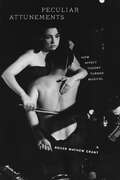
Peculiar Attunements: How Affect Theory Turned Musical
Par Roger Mathew Grant. 2020
Peculiar Attunements places the recent turn to affect into conversation with a parallel movement in European music theory of the…
eighteenth century. During that time the affects—or passions, as they were also called—formed a vital component of a mimetic model of the arts. Eighteenth-century critics held that artworks imitated or copied the natural world in order to produce copies of the affects in their beholders. But music caused a problem for such theories, since it wasn’t apparent that musical tones could imitate anything with any dependability, beyond the rare thunderclap or birdcall.Struggling to articulate how it was that music managed to move its auditors without imitation, certain theorists developed a new affect theory crafted especially for music, postulating that music’s physical materiality as sound vibrated the nerves of listeners and attuned them to the affects through sympathetic resonance. This was a theory of affective attunement that bypassed the entire structure of representation, offering a non-discursive, corporeal alternative. It is a pendant to contemporary theories of affect, and one from which they have much to learn. Inflecting our current intellectual moment through eighteenth-century music theory and aesthetics, this book offers a reassessment of affect theory’s common systems and processes. It offers a new way of thinking through affect dialectically, drawing attention to patterns and problems in affect theory that we have been given to repeating. Finally, taking a cue from eighteenth-century theory, it gives renewed attention to the objects that generate affects in subjects.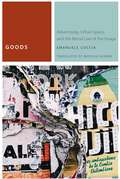
Goods: Advertising, Urban Space, and the Moral Law of the Image (Commonalities)
Par Emanuele Coccia. 2018
Objects are all around us – and images of objects, advertisements for objects. Things are no longer merely purely physical…
or economic entities: within the visual economy of advertising, they are inescapably moral. Any object, regardless of its nature, can for at least a moment aspire to be “good,” can become not just an object of value but a complex of possible happiness, a moral source of perfection for any one of us.Our relation to things, Coccia, argues in this provocative book, is what makes us human, and the object world must be conceived as an ultimate artifact in order for it to be the site of what the philosophical tradition has considered "the good." Thinking a radical political praxis against a facile materialist critique of things, Coccia shows how objects become the medium through which a city enunciates its ethos, making available an ethical life to those who live among them.When we acknowledge that our notion of “the good” resides within a world of things, we must grant that in advertising, humans have revealed themselves as organisms that are ethically inseparable from the very things they produce, exchange, and desire. In the advertising imaginary, to be human is to be a moral cyborgs whose existence attains ethical perfection only via the universe of things. The necessary alienation which commodities cause and express is moral rather than economic or social; we need our own products not just to survive biologically or to improve the physical conditions of our existence, but to live morally. Ultimately, Coccia’s provocative book offers a radically political rethinking of the power of images. The problem of contemporary politics is not the anesthetization of words but the excess power we invest in them. Within images, we already live in another form of political life, which has very little to do with the one invented and formalized by the ancient and modern legal tradition. All we need to do is to recognize it. Advertising and fashion are just the primitive, sometimes grotesque, but ultimately irrepressible prefiguration of the new politics to come.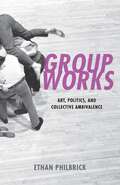
Group Works: Art, Politics, and Collective Ambivalence
Par Ethan Philbrick. 2023
An exciting new reflection on the role of artistic collaboration, collectivism, and the politics of group formation in the neoliberal…
era.The artist and author Ethan Philbrick’s Group Works re-imagines the group by undertaking an historiographic archaeology of group aesthetics and politics.Written against both phobic and romantic accounts of collectivity, Group Works contends that the group emerges as a medium for artists when established forms of collective life break down. Philbrick pairs group pieces in dance, literature, film, and music from the 1960s and 1970s downtown Manhattan scene alongside a series of recent group experiments: Simone Forti’s dance construction, Huddle (1961), is put into relation with contemporary re-performances of Forti’s score and huddling as a feminist political tactic; Samuel Delany’s memoir of communal living, Heavenly Breakfast: An Essay on the Winter of Love (1969/78), speaks to performance artist Morgan Bassichis’s 2017 communal musical adaptation of Larry Mitchell’s 1977 text, The Faggots and Their Friends Between Revolutions; Lizzie Borden’s experimental documentary of feminist collectivity, Regrouping (1976), sits alongside visual artist Sharon Hayes’s 2014 piece on Manhattan’s Pier 54, Women of the World Unite! they said; and Julius Eastman’s insurgent piece of chamber music for four pianos, Gay Guerrilla (1979), resonates alongside contemporary projects that take up Eastman’s legacy by artists such as Tiona Nekkia McClodden.By analyzing works that articulate the politics of race, gender, and sexuality as questions of group formation, Philbrick approaches the group not as a stable, idealizable entity but as an ambivalent way to negotiate and contest shifting terms of associational life. Group Works presents an engaging exploration of what happens when small groups become a material and medium for artistic and political experimentation.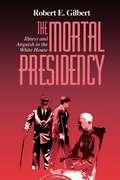
The Mortal Presidency: Illness and Anguish in the White House
Par Robert E. Gilbert. 1998
Available in a new digital edition with reflowable text suitable for e-readersThe presidency is hazardous to your health. Fully two-thirds…
of our presidents have died before reaching their life-expectancy- despite being wealthier, better educated, and better cared for that most Americans. In Mortal Presidency, the first complete account of death and illness in the White House, Robert E. Gilbert looks at modern presidents including Coolidge, FDR, Eisenhower, Kennedy, and Reagan. He shows- in some cases, for the first time- that all suffered from debilitating medical problems, physical and/or psychological, which they frequently managed to conceal from the public but which, in important ways, affected their political lives. This edition is updated to include a brief look at Presidents Clinton and Bush, both of whom suffered sudden and unpleasant indispositions while in office which to some degree affected their presidencies.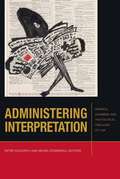
Administering Interpretation: Derrida, Agamben, and the Political Theology of Law (Just Ideas)
Par Peter Goodrich and Michel Rosenfeld. 2019
Populism in politics and policy orientations in law have thrown the jurisdiction of the academy and the disciplines of interpretation…
into disarray. Critique flounders in abstraction and negativity, law loses itself in particularity. Administering Interpretation brings together philosophers, humanists, and jurists from both continental and Anglophone jurisdictions to reassess the status and trajectory of interpretative theory as applied in the art of law. Tracking the thread of philosophical influences upon the community of legal interpretation, the essays move from the translation and wake of Derrida to the work of Agamben, from deconstruction to oikononmia. Sharing roots in the philological excavation of the political theology of modern law, contributors assess the failure of secularism and the continuing theological borrowings of juridical interpretation. The book brings contemporary critique to bear upon the interpretative apparatuses of exclusion, the law of spectacular sovereignty, and the bodies that lie in its wake.Contributors: Giovanna Borradori, Marinos Diamantides, Allen Feldman, Stanley Fish, Pierre Legrand, Bernadette Meyler, Michel Rosenfeld, Bernhard Schlink, Jeanne Schroeder, Laurent de Sutter, Katrin Trüstedt, Marco Wan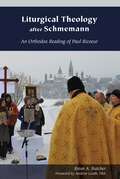
While only rarely reflecting explicitly on liturgy, French philosopher Paul Ricoeur (1913-2005) gave sustained attention to several themes pertinent to…
the interpretation of worship, including metaphor, narrative, subjectivity, and memory. Inspired by his well-known aphorism, “The symbol gives rise to thought,” Liturgical Theology after Schmemann offers an original exploration of the symbolic world of the Byzantine Rite , culminating in a Ricoeurian analysis of its Theophany “Great Blessing of Water.” . The book examines two fundamental questions: 1) what are the implications of the philosopher’s oeuvre for liturgical theology at large? And 2)how does the adoption of a Ricoeurian hermeneutic shape the study of a particular rite? Taking the seminal legacy of Orthodox theologian Alexander Schmemann (1921-1983) as its point of departure, Butcher contributes to the renewal of contemporary Eastern Christian thought and ritual practice by engaging a spectrum of current theological and philosophical conversations.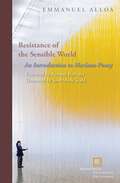
In this book, Emmanuel Alloa offers a handrail for venturing into the complexities of the work of the French philosopher…
Maurice Merleau-Ponty (1908–61). Through a comprehensive analysis of the three main phases of Merleau-Ponty’s thinking and a thorough knowledge of his many unpublished manuscripts, the author traces how Merleau-Ponty’s philosophy evolved and exposes the remarkable coherence that structures it from within. Alloa teases out the continuity of a motive that traverses the entire oeuvre as a common thread. Merleau-Ponty struggled incessantly against any kind of ideology of transparency, whether of the world, of the self, of knowledge, or of the self’s relation to others.Already translated into several languages, Alloa’s innovative reading of this crucially important thinker shows why the issues Merleau-Ponty raised are, more than ever, those of our time.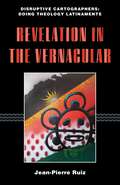
Revelation in the Vernacular (Disruptive Cartographers: Doing Theology Latinamente)
Par Jean-Pierre Ruiz. 2021
Association of Catholic Publishers 2022 Excellence in Publishing Awards: First Place, TheologyCatholic Media Association, Honorable Mention in Theology: Morality, Ethics,…
Christology, Mariology, and RedemptionUnveiling divine mysteries across continents and centuries.Revelation in the Vernacular retrieves a hermeneutics of the vernacular that is rooted en lo cotidiano, in everyday life and experience. Traversing time and geography, Ruiz remaps a theology of revelation done latinamente, beginning with sixteenth-century encounters of Spanish colonizers with Indigenous peoples in the Caribbean. Drawing on the theology of the Incarnation articulated by Fray Luis de León (1527–91), he offers rich resources for interreligious engagement by believers in today’s religiously diverse world. Through an analysis of the documents of the 2019 Amazonian Synod, including Querida Amazonia, the Postsynodal Exhortation by Pope Francis, he explores a culture of encounter and dialogue that has been a hallmark of this pontificate. From the inscriptions in the caves of la Isla de Mona through the writings of the Latin American Bishops (CELAM), this book establishes a solid basis on which to discern the “Seeds of the Word” in our times.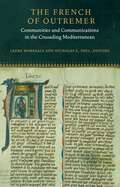
The French of Outremer: Communities and Communications in the Crusading Mediterranean (Fordham Series in Medieval Studies)
Par Laura K. Morreale and Nicholas L. Paul, Editors. 2018
The establishment of feudal principalities in the Levant in the wake of the First Crusade (1095-1099) saw the beginning of…
a centuries-long process of conquest and colonization of lands in the eastern Mediterranean by French-speaking Europeans. This book examines different aspects of the life and literary culture associated with this French-speaking society. It is the first study of the crusades to bring questions of language and culture so intimately into conversation. Taking an interdisciplinary approach to the study of the crusader settlements in the Levant, this book emphasizes hybridity and innovation, the movement of words and people across boundaries, seas and continents, and the negotiation of identity in a world tied partly to Europe but thoroughly embedded in the Mediterranean and Levantine context.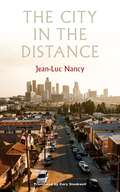
The City in the Distance
Par Jean-Luc Nancy. 2025
FINALIST, 38th ANNUAL FRENCH-AMERICAN FOUNDATION TRANSLATION PRIZEExploring the ever-changing philosophy of city life with Jean-Luc NancyIn The City in the…
Distance, Jean-Luc Nancy embarks on nothing less than a philosophy of the city. Drawing on his widely discussed accounts of sense and of the fraught question of community, Nancy views the city as the site of a disposition that is constantly undergoing metamorphoses.Far from an abstract account, Nancy attends in the most concrete way possible to the workings of a city not typically taken as paradigmatic, Los Angeles. As Jean-Christophe Bailly suggests in his foreword, Nancy joins Walter Benjamin in thinking the city not from an external vantage point, but on its own terms.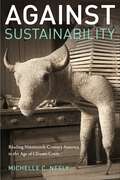
Against Sustainability: Reading Nineteenth-Century America in the Age of Climate Crisis
Par Michelle Neely. 2020
Against Sustainability responds to the twenty-first-century environmental crisis by unearthing the nineteenth-century U.S. literary, cultural, and scientific contexts that gave…
rise to sustainability, recycling, and preservation. Through novel pairings of antebellum and contemporary writers including Walt Whitman and Lucille Clifton, George Catlin and Louise Erdrich, and Herman Melville and A. S. Byatt, the book demonstrates that some of our most vaunted strategies to address ecological crisis in fact perpetuate environmental degradation.Yet Michelle C. Neely also reveals that the nineteenth century offers useful and generative environmentalisms, if only we know where and how to find them. Henry David Thoreau and Emily Dickinson experimented with models of joyful, anti-consumerist frugality. Hannah Crafts and Harriet Wilson devised forms of radical pet-keeping that model more just ways of living with others. Ultimately, the book explores forms of utopianism that might more reliably guide mainstream environmental culture toward transformative forms of ecological and social justice. Through new readings of familiar texts, Against Sustainability demonstrates how nineteenth-century U.S. literature can help us rethink our environmental paradigms in order to imagine more just and environmentally sound futures.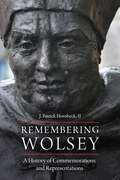
Remembering Wolsey: A History of Commemorations and Representations
Par J. Patrick II. 2019
Remembering Wolsey seeks to contribute to our understanding of historical memory and memorialization by examining in detail the commemoration and…
representation of the life of Thomas Wolsey, the sixteenth-century cardinal, papal legate, and lord chancellor of England. Hornbeck surveys a wide range of representations of Cardinal Wolsey, from those contemporary with his death to recent mass-market appearances on television and historical fiction, to go beyond previous scholarship that has examined Wolsey only in an early modern context.Remembering Wolsey contributes significantly to the ongoing reimagining of English church history in the years prior to the Reformation. Surveying chronicle accounts, pamphlets, plays, poems, historical fictions, works of historical scholarship, civic pageants and monuments, films, and television programs, the book shows how an extended sequence of authors have told widely varying stories about Wolsey’s life, often through the lens of their own religious and ideological commitments and/or in response to the pressing concerns of their times.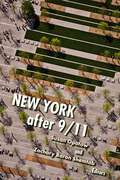
New York After 9/11
Par Susan Opotow and Zachary Baron Shemtob, editors. 2018
An estimated 2 billion people around the world watched the catastrophic destruction of the World Trade Center. The enormity of…
the moment was immediately understood and quickly took on global proportions. What has been less obvious is the effect on the locus of the attacks, New York City, not as a seat of political or economic power, but as a community; not in the days and weeks afterward, but over months and years. New York after 9/11 offers insightful and critical observations about the processes set in motion by September 11, 2001 in New York, and holds important lessons for the future. This interdisciplinary collection brings together experts from diverse fields to discuss the long-term recovery of New York City after 9/11. Susan Opotow and Zachary Baron Shemtob invited experts in architecture and design, medicine, health, community advocacy, psychology, public safety, human rights, law, and mental health to look back on the aftereffects of that tragic day in key spheres of life in New York City. With a focus on the themes of space and memory, public health and public safety, trauma and conflict, and politics and social change, this comprehensive account of how 9/11 changed New York sets out to answer three questions: What were the key conflicts that erupted in New York City in 9/11’s wake? What clashing interests were involved and how did they change over time? And what was the role of these conflicts in the transition from trauma to recovery for New York City as a whole?Contributors discuss a variety of issues that emerged in this tragedy’s wake, some immediately and others in the years that followed, including: PTSD among first responders; conflicts and design challenges of rebuilding the World Trade Center site, the memorial, and the museum; surveillance of Muslim communities; power struggles among public safety agencies; the development of technologies for faster building evacuations; and the emergence of chronic illnesses and fatalities among first responders and people who lived, worked, and attended school in the vicinity of the 9/11 site. A chapter on two Ground Zeros –in Hiroshima and New York – compares and historicizes the challenges of memorialization and recovery. Each chapter offers a nuanced, vivid, and behind-the-scenes account of issues as they unfolded over time and across various contexts, dispelling simplistic narratives of this extended and complicated period. Illuminating a city’s multifaceted response in the wake of a catastrophic and traumatic attack, New York after 9/11 illustrates recovery as a process that is complex, multivalent, and ongoing.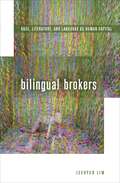
Bilingual Brokers: Race, Literature, and Language as Human Capital
Par Jeehyun Lim. 2017
Reading Asian American and Latino literature, Bilingual Brokers traces the shift in attitudes toward bilingualism in postwar America from the…
focus on cultural assimilation to that of resource management. Interweaving the social significance of language as human capital and the literary significance of English as the language of cultural capital, Jeehyun Lim examines the dual meaning of bilingualism as liability and asset in relation to anxieties surrounding “new” immigration and globalization.Using the work of Younghill Kang, Carlos Bulosan, Américo Paredes, Maxine Hong Kingston, Richard Rodriguez, Chang-rae Lee, Julia Alvarez, and Ha Jin as examples, Lim reveals how bilingual personhood illustrates a regime of flexible inclusion where an economic calculus of one’s value crystallizes at the intersections of language and racial difference. By pointing to the nexus of race, capital, and language as the focal point of postwar negotiations of difference and inclusion, Bilingual Brokers probes the faultlines of postwar liberalism in conceptualizing and articulating who is and is not considered to be an American.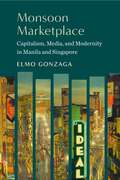
Monsoon Marketplace: Capitalism, Media, and Modernity in Manila and Singapore
Par Elmo Gonzaga. 2024
Provides vivid accounts of commercial and leisure spaces that captivated the public imagination in the past but have since been…
destroyed, forgotten, or refurbished.Monsoon Marketplace uncovers the entangled vernacular cultures of capitalist modernity, mass consumption, and media spectatorship in two understudied postcolonial Asian cities across three crucial historical moments. Juxtaposing Manila and Singapore, it analyzes print and audiovisual representations of popular commercial and leisure spaces during the colonial occupation in the 1930s, national development in the 1960s, and neoliberal globalization in the 2000s. Engaging with the work of creators including Nick Joaquin, Kevin Kwan, and P. Ramlee, it discusses figures of female shoppers in 1930s Manila, languid expatriates in 1930s Singapore, street hawkers in 1960s Singapore, youthful activists in 1960s Manila, call center agents in 2000s Manila, and super-rich investors in 2000s Singapore. Looking at the historical transformation of Calle Escolta, Avenida Rizal, Raffles Place, and Orchard Road, it focuses on Crystal Arcade, the Manila Carnival, the Great World and New World Amusement Parks, and Change Alley, all of which had once captivated the public imagination but have since vanished from the cityscape. Instead of treating capitalism, media, and modernity as overarching systems or processes, the book examines how their configurations and experiences are contingent, variable, pluralistic, and archipelagic. Diverging from critical theories and cultural studies that see consumerism and spectatorship as sources of alienation, docility, and fantasy, it explores how they create new possibilities for agency, collectivity, and resistance.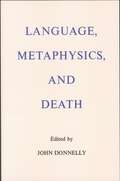
Language, Metaphysics, and Death
Par John Donnelly. 1978
Available in a new digital edition with reflowable text suitable for e-readersThis standard work in thanatology is updated with ten…
essays new to the second edition, and features a new introduction by Donnelly. The collection addresses certain basic issues inherent in a philosophy of death.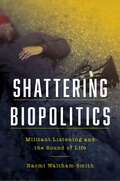
Shattering Biopolitics: Militant Listening and the Sound of Life (Commonalities)
Par Naomi Waltham-Smith. 2021
A missed phone call. A misheard word. An indiscernible noise. All these can make the difference between life and death.…
Failures to listen are frequently at the root of the marginalization and exclusion of certain forms of life. Audibility decides livability. Shattering Biopolitics elaborates for the first time the intimate and complex relation between life and sound in recent European philosophy, as well as the political stakes of this entanglement.Nowhere is aurality more pivotal than in the dialogue between biopolitical theory and deconstruction about the power over and of life. Closer inspection of these debates reveals that the main points of contention coalesce around figures of sound and listening: inarticulate voices, meaningless sounds, resonant echoes, syncopated rhythms, animal cries, bells, and telephone rings.Shattering Biopolitics stages a series of “over-hearings” between Jacques Derrida and Giorgio Agamben who often mishear or completely miss hearing in trying to hear too much. Notions of power and life are further diffracted as Hélène Cixous, Catherine Malabou, and Jean-Luc Nancy join in this high-stakes game of telephone. This self-destructive character of aurality is akin to the chanciness and risk of death that makes life all the more alive for its incalculability.Punctuating the book are a series of excurses on sound-art projects that interrogate aurality’s subordination and resistance to biopower from racialized chokeholds and anti-migrant forensic voice analysis to politicized speech acts and activist practices of listening.Shattering Biopolitics advances the burgeoning field of sound studies with a new, theoretically sophisticated analysis of the political imbrications of its object of inquiry. Above all, it is sound’s capacity to shatter sovereignty, as if it were a glass made to vibrate at its natural frequency, that allows it to amplify and disseminate a power of life that refuses to be mastered.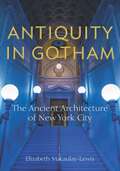
Antiquity in Gotham: The Ancient Architecture of New York City
Par Elizabeth Macaulay-Lewis. 2021
The first detailed study of “Neo-Antique” architecture applies an archaeological lens to the study of New York City’s structuresSince the…
city’s inception, New Yorkers have deliberately and purposefully engaged with ancient architecture to design and erect many of its most iconic buildings and monuments, including Grand Central Terminal and the Soldiers’ and Sailors’ Memorial Arch in Brooklyn, as well as forgotten gems such as Snug Harbor on Staten Island and the Gould Memorial Library in the Bronx. Antiquity in Gotham interprets the various ways ancient architecture was re-conceived in New York City from the eighteenth century to the early twenty-first century. Contextualizing New York’s Neo-Antique architecture within larger American architectural trends, author Elizabeth Macaulay-Lewis applies an archaeological lens to the study of the New York buildings that incorporated these various models in their design, bringing together these diverse sources of inspiration into a single continuum. Antiquity in Gotham explores how ancient architecture communicated the political ideals of the new republic through the adaptation of Greek and Roman architecture, how Egyptian temples conveyed the city’s new technological achievements, and how the ancient Near East served many artistic masters, decorating the interiors of glitzy Gilded Age restaurants and the tops of skyscrapers. Rather than classifying neo-classical (and Greek Revival), Egyptianizing, and architecture inspired by the ancient Near East into distinct categories, Macaulay-Lewis applies the Neo-Antique framework that considers the similarities and differences—intellectually, conceptually, and chronologically—among the reception of these different architectural traditions. This fundamentally interdisciplinary project draws upon all available evidence and archival materials—such as the letters and memos of architects and their patrons, and the commentary in contemporary newspapers and magazines—to provide a lively multi-dimensional analysis that examines not only the city’s ancient buildings and rooms themselves but also how New Yorkers envisaged them, lived in them, talked about them, and reacted to them. Antiquity offered New Yorkers architecture with flexible aesthetic, functional, cultural, and intellectual resonances—whether it be the democratic ideals of Periclean Athens, the technological might of Pharaonic Egypt, or the majesty of Imperial Rome. The result of these dialogues with ancient architectural forms was the creation of innovative architecture that has defined New York City’s skyline throughout its history.